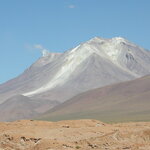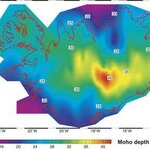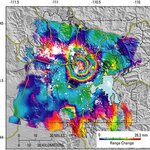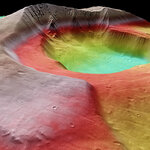Geology

Given that there has been some recent interest in Uturuncu in the media, when this paper from the Bulletin of Volcanology came up among my RSS feeds it instantly piqued my interest. Titled "Shallow seismicity, triggered seismicity, and ambient noise tomography at the long-dormant Uturuncu Volcano, Bolivia", it reports the findings from a seismic survey of the volcano between April 2009 and April 2010.
Uturuncu volcano A volcano near Uturuncu, in Bolivia. Photo CC BY-SA by einalem.Uturuncu is in a remote part of the Bolivian Andes, and hasn't erupted for the last 271,000 years.…

As my last few blogs have been a bit heavy on the science, I thought I'd write something a bit lighter. So here are some pretty pictures of the fieldwork for master's project, when I went to Pantelleria to measure the CO2 degassing that was occurring there.
Favare Grande, a fumarole on Pantelleria.Never heard of Pantelleria? Neither had I before I started my master's. It is a little known volcano half-way between Sicily an Tunisia, and is a little bit of an oddity. Africa is currently crashing into Europe, but despite this the area around Pantelleria is extending.…

Iceland is always referred to as an oceanic island on an oceanic ridge protruded above the Atlantic sea level. Under the aegis of Plate Tectonic Concepts(PTC), this island is considered as the real time evidence of lithospheric spreading. In the wake of new geophysical data, apprehensions are more about the spreading concepts of lithosphere and related geodynamics. This paper looks into a few important facts, which negate the PTC on Iceland.
The ideas of lateral drift
and sea floor spreading took hold in the late 1960s, followed which the unexpected xenoliths in
surface volcanics of…

In the first part of this look at magma chambers, I talked about some of the processes that dominate what goes on beneath an active volcano. The twin actions of fractionation and assimilation were what preoccupied the early researchers, however more recently we've realised things are a little more complicated than that. In this part I want to take a closer look at some of those intricacies.
As I mentioned in the first part, Skaergaard drove much of the early research. While its simplicity allowed easy interpretation of its magmatic history, people began to imagine all magma…

Planet Earth: Extreme Beauty – Extreme Danger
The story about the newlyweds who went on a trip one could arguably characterize as a Honeymoon From Hell swirled around in the news-world for some time in spring 2011. During a four-month trip, newlyweds Erika and Stefan Svanstrom and their baby girl survived a snowstorm in Germany, a bush fire, a cyclone and the Queensland floods in Australia, the Christchurch earthquake in New Zealand and finally Japan's earthquake and tsunami. As unlikely as this story would sound if we didn't know it actually happened, I still want to present you with a…

The moon has no global magnetic field yet Apollo astronauts found magnetized rocks on the lunar surface.
A new hypothesis proposes a mechanism that could have generated a magnetic field on the moon early in its history. The 'geodynamo' that generates Earth's magnetic field is powered by heat from the inner core, which drives complex fluid motions in the molten iron of the outer core. The moon is too small to support that type of dynamo but the researchers write in Nature that an ancient lunar dynamo could have arisen from stirring of the moon's liquid core driven by the…

This post is the first of a new series I plan to write, on the techniques used to study and monitor volcanoes. The reason science is the best method we have of investigating the world around us is not so much what we know, but how we know it. I thought I'd start with a technique that always amazes me; we can measure centimetres of ground deformation over an area of many square kilometres, from an altitude of 800 km. Interferometric Synthetic Aperture Radar, InSAR for short.
Regular SAR works by firing a pulse of radio waves towards the Earth, and timing how long it takes to…

Want to get people excited about space exploration? Continue to use D&D-style names like Tharsis Tholus for geological features on Mars and every young man in the world will want to visit.
By Earth standards, Tharsis Tholus is a giant, towering nearly 4 miles above the surrounding terrain (the height of Mount Everest), with a base stretching 20 times that. On Mars, it is just so-so in size. The shield volcano, Olympus Mons, which also rests in the vast upland region Tharsis is, at 26 km, the highest known mountain in the Solar System, but the condition of Tharsis…
What goes on underneath the most deadly volcanoes? As my PhD investigates the processes that occur below the ground on Santorini, I thought I would try to explain some of what goes on under every active volcano.We have long known that many of the Earth's rocks are formed by the solidification of molten rock. Since James Hutton wrote his 1788 book 'The Theory of Earth', granite has been acknowledged to be formed by the solidification of molten rock. Since then, large granitic bodies, along with their andesitic and gabbroic equivalents, have been recognised as 'fossil magma…

The Hayward fault runs smack dab through the UC Berkeley football stadium; it is being retrofitted this year.
In the last week, there have been 3 earthquakes on or near the campus, with a magnitude of 4.0 (last Thursday afternoon), 3.8 (last Thursday evening), and 3.6 (this morning).
On a traditional GPA scale, 4.0 is a perfect grade score of straight A's. So the mean (and median) GPA for UC Berkeley is now 3.8.
What do you say to that, San Andreas Fault and Stanford University? Unwilling or unable to compete (or both)?